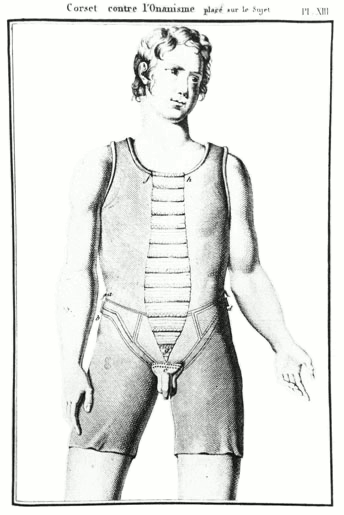
 Corset anti-onanisme tiré du livre de Guillaume Jalade-Lafont, "Considérations sur la confection de corsets et des ceintures propres à s'opposer à la pernicieuse habitude de l'onanisme", 1819.
Corset anti-onanisme tiré du livre de Guillaume Jalade-Lafont, "Considérations sur la confection de corsets et des ceintures propres à s'opposer à la pernicieuse habitude de l'onanisme", 1819.
During the 17th and 18th centuries, onanist practices were lumped together with masturbation. The two terms became differentiated in the 19th century. Whereas the former refers to sexual gratification achieved via coitus interruptus, the latter more simply involves the manual stimulation of one’s own sexual organs (manustupration, “the act of defiling with the hand”).
The term onanism can be traced back to the Biblical story of Onan’s crime. Onan refused to inseminate his brother’s widow and chose to “[emit] on the ground lest he should give an heir to his brother” and was punished by God. So, Onan performed coitus interruptus, or withdrawal, giving his name to the practice. 17th century Church authorities confused Onan’s act with masturbation, which they associated to sterility. This negative coupling is emphasised by bishops and abbots who castigate severely clerical solitary pleasures which they term “nocturnal pollution”.
In the 18th century the fight against masturbation takes a fresh turn when Samuel Auguste Tissot’s anti-masturbation campaign yields his Onanism A treatise on the diseases produced by onanism, published in 1760 as a translation from his Latin original: Tentamen de morbis ex manustupratione, (“and considerably augmented by the author”) – perhaps inspired by Balthazar Bekker’s 1710 Onania. Both physicians consider onanism a sexual transgression that demeans good living. Their essays were translated and broadly disseminated across Europe proposing self-help solutions and introducing the term “onanism” in Diderot’s Encyclopaedia. Several Enlightenment luminaries, congratulated Tissot and Becker among which Rousseau and Voltaire, the latter writing to Tissot’s that his “book is a service rendered to mankind”
The end of the 18th century sees a surge of sexual repression that will alter sexual practices right into the 20th. It is during this latter period that neurologist Sigmund Freud theorizes his anxiety neurosis, a state which encapsulates all the ills Tissot and Bekker blame on masturbation. Starting with the weakening of intellectual faculties (memory failures, dementia, state of anxiety, hysteria, swooning…) it progresses to the weakening of physical strength (arrested growth, tiredness, palpitations, suffocations, vertigo, coughs, fevers…) to pains in the head, the chest, the stomach, the joints, the intestines and frequent torpors. A second phase brings in physical blemishes (pimples, pustules, rashes…), sexual disorders (erectile dysfunction, premature ejaculation, penile discharge, weak ejaculation, testicular tumours, male impotence, sterility, to end with intestinal complaints (constipation, haemorrhoids, diarrhoea, rectal discharge).
The books against masturbation are aimed specifically at parents whose young people are affected by this practice. They give rise to A great many tools as well as preventive protocols to fight the “condition”. Doctors advise first a discussion leading to avowal and a reminder of the divine retribution meted out to “sex delinquents”. This first phase accomplished, the patients are prescribed potions, lotions, sedatives, narcotics, and hygienic rules (cold bath with iron filings, no lie-in, no inaction, no tight trousers, no licentious books). This is accompanied by an array of inventions designed to prevent the youths from touching themselves and thus “preserve their health”; those include protective systems (a sort of penis corset) the application of leeches on genital zones, studded gloves, wristcuffs, straitjackets; some doctors set forth extreme solutions for the “recidivists” through surgery, excision and ablation.
Reacting to such restrictions, the “masturbators” invented several erotic accessories intended to increase or hasten pleasure. Among them the “masturbateuse” (a hand operated to arouse through caressing), the glans vice aka “sphynx’ pincers” (a velvet coated vice used to press the glans from left to right towards the ejaculatory spasm as orgasm is reached, “Sara’s jaws” (a stuffed lioness’ head) and “the countess’ pissoir” a receptacle for the semen from joint ejaculations).
With the 20th century came the age of “beneficent masturbation” with sexologists like Iwan Bloch, Auguste Forel or say Wilhelm Stekel who consider it a normal practice bereft of any danger. It would still take a few more years before masturbation becomes a socially acceptable practice
Read more in the dictionary : Clitoris
Read the paper in French : Onanisme
References :
Georges Androutsos, “De l’onanisme à la masturbation. Une note historique”, Andrologie, 15, 2005, p. 71–79.
Janine Mossuz-Lavau, Dictionnaire des sexualités, Robert Laffont, 2014.
To quote this paper : Colombe Doiteau, “Onanism”, in Hervé Guillemain (ed.), DicoPolHiS, Le Mans Université, 2024.